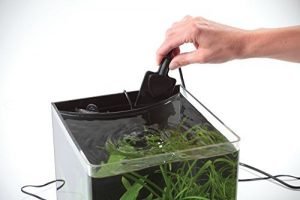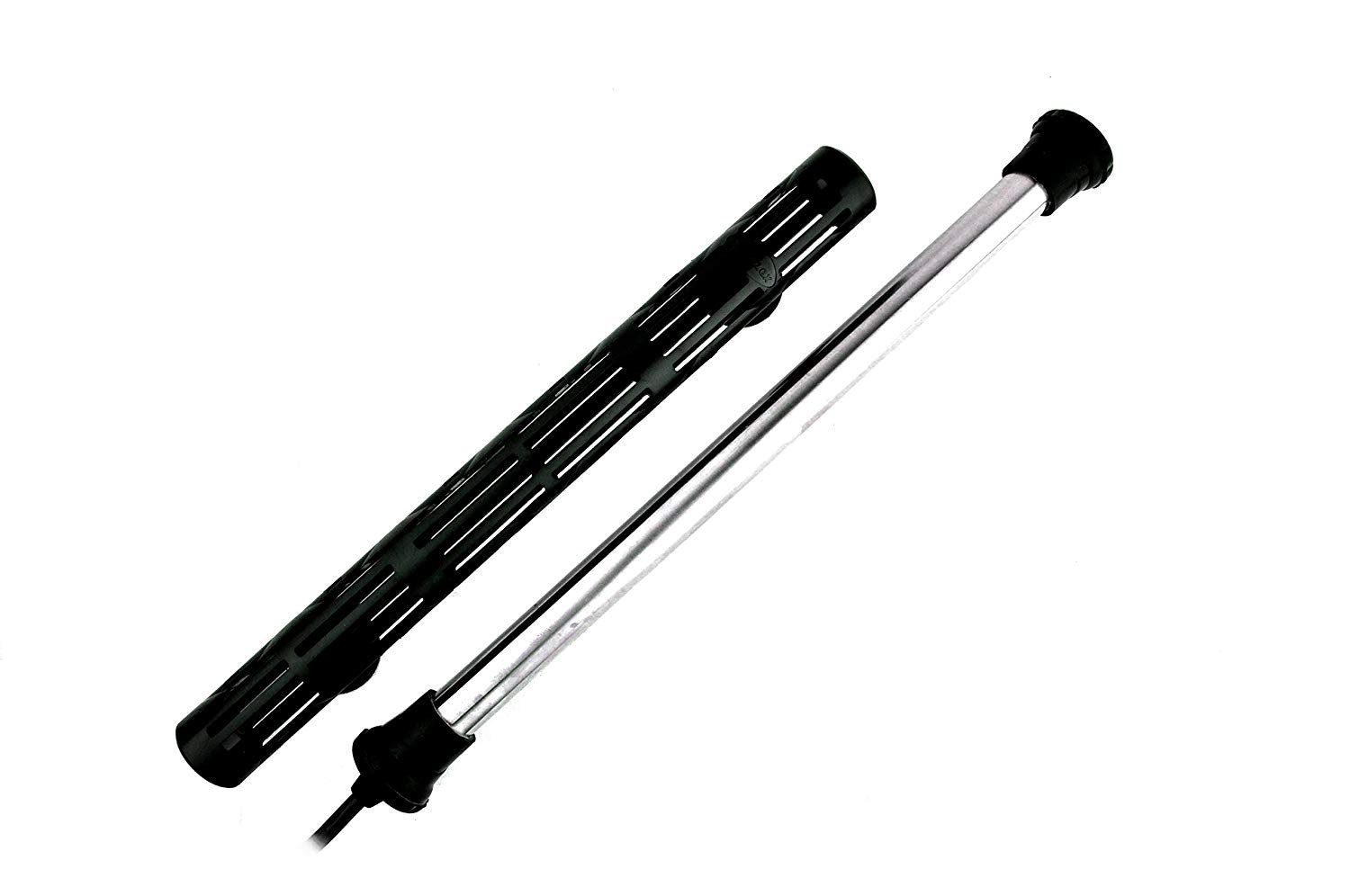When choosing the right heater you need to factor your budget, tank size, fish size potential, ambient room temperature variation, and temperature sensitivity.
Often when heater problems occur it is due to the heater being the wrong size for the aquarium.
Too high a heater wattage can result in rapid temperature rises that can result in cooked fish if you make adjustment mistakes.
It is important of all heaters, regardless of type to maintain good circulation around the heater for the best results for temperature control and accuracy.
Titanium Heaters are best used inside the main display aquarium where the heat will dissipate more rapidly than in a sump or similar enclosed space. Titanium Heaters can over heat and burn out when used in small sumps or heater modules.
Glass/quartz submersible heaters are better in sumps or similar as glass/quartz submersible heaters do not seem to be as sensitive to this problem.
Contents
TITANIUM/ STAINLESS STEEL/ REMOTE SENSOR HEATERS
The advantages to these heaters are three fold;
One: is that they tend to be even more accurate by having the sensor far from the heating element.
Two: besides improved accuracy of a remote sensor, the accuracy is further improved by the Digital electronics of the newest generation Titanium Heaters.
Three: the Titanium (and also Stainless Steel) heaters are much more durable and difficult to break especially with large fish such as Oscars.
These heaters also resist breakage due to aquarist mistakes such as leaving them on during water changes or dropping rocks on them (although Titanium heaters still can be damaged by leaving them on during a water change).
I think Titanium Heaters are your best choice for very large aquariums and for aquariums with large and destructive fish such as Arowanas, Oscars or even Turtle tanks (provided there is adequate water volume).
Also if accuracy of temperature control coupled with durability is important, especially with marine aquariums or Discus aquariums, the Digital Titanium is for you.
Titanium Heaters are NOT as good a choice for placing in confined spaces such as sumps, low water tanks (such as Viviariums) or filters such as the ReSun Internal Wet Dry Filter as Titanium heaters tend to easily overheat in confined spaces.
In the case of a sump, the reasons for spending extra for a Titanium heater which are impact resistance and the remote sensor are lost in this small space where the remote sensor is of little advantage and as well no fish are present that might damage a more fragile glass or quartz heater.
IN-LINE AQUARIUM HEATERS (or In-Filter Heaters)
The inline aquarium heater has come in and out of popularity in a few variations since at least the 1970s.
One form was the “heater module” in which to place your standard submersible heater inside of this “module”. An example is the Lifeguard Heater Module which is the one I used the most; in fact I even designed one many years back to sell and utilize in my aquarium maintenance business.
Another variation is the specific in-line aquarium heater such as the Hydor ETH.
The third method (more similar to the first) is the use of canister aquarium filters with specific ports in which to place your heater.
This all said, all these methods have one thing in common from considerable use/experience on my part, and that these inline heater often are NOT that accurate and more importantly fail at a much higher rate that more conventional aquarium heating methods.
This is why I stopped selling and making my own heater module as the failure rates and poor heating results were no better than others no matter how much I “tweaked it”.
Part of the reason is the confined space does not allow for accurate temperature reading from the heaters sensors. As well this confined space often results in too much heat inside this unit that contains the actual heater/heating element, resulting in overheats and premature heater failure.
The bottom line is although on the surface this may seem like a good idea, in practicality it is a flawed idea that has been doomed to failure in every design I have tried or designed.
If you desire this method due to large and destructive fish, consider a Titanium Heater.
If your reason is less equipment in the aquarium, consider placing your heater in a large sump system with much better circulation around the heater.
Of course this option is not possible to the majority of readers, so my suggestion is to simply hide your heater with decor, make sure to have a drip loop for safety, and simply realize that this minor inconvenience of a heater inside your aquarium is better than a failed heater or over heat of your aquarium.
One final issue with in-line heaters if used with an in-line UV Sterilizer, do NOT use together or at the very least use after the UV Sterilizer.
The reason? These heaters are notorious for having hot spots in the water just after the heater than can over heat a UV lamp and considerably shorten life, especially in low flow applications.
AUTOMATIC OR NON-PRESET HEATERS (Hang on the Back Heaters)
The Non-Preset or Automatic heater such as the basic Radiant Heater has a very remedial thermostat; or better they have metal contacts that are tightened by turning the dial (metal contacts installed on bi-metal lead, which are brought together with an adjusting screw).
When the heater is “turned up” or tightened, it turns on for longer periods of time. In other words these heaters are “automatic” not thermostatic as they do not go on based on water temperatures, rather the “time” it takes for a contact to “break” due to the tightness of the adjustment.
These heaters need adjustments between summer and winter.
Examples of this heater are the Radiant by Hagen, or even the old Metaframe heaters. Sometimes these heaters are all some aquarists can fit or afford on their tank (although Thermostatic heaters have come down in price a lot), but many an aquarist cook their fish with these, as subtle changes in the dial often over correct and a sudden ambient warm spell is often not corrected for in time.
With these heaters it is imperative that the water level is kept up to the proper level as marked on the heater or they may crack, it is also important to check these for seasonal variations (Summer/Winter), as these heaters adjust poorly for these.
These should not be used in a room or garage with wide temperature swings as they will not generally adjust properly. Adjustments with these heaters should be made at no more than 1/8 turn at a time then wait for about two hours before the next adjustment.
As with other heaters it is a good idea to place the heater in the tank and wait for 30 minutes before plugging in (although this is less important with these automatic heaters).
Adjustments should be made very gradually and it is easier to adjust these heaters if you start out at our near the desired temperature, otherwise you may be in for a roller coaster of adjustments.
OTHER AQUATIC HEATING DEVICES; Including Under Gravel Mini Heaters:
As for heating betta in a small tank or bowl, this can be difficult with even the smallest aquarium heaters as they tend to be less accurate in very small volumes of water.
 One method for heating bowls or small aquariums under 5 gallons are the Hydor Mini Undergravel Heaters.
One method for heating bowls or small aquariums under 5 gallons are the Hydor Mini Undergravel Heaters.
These heaters are completely submersible, easy to hide in mini tanks and bowls and safe even under gravel. There is no controller for this type of heater, instead the Mini undergravel heater simply increases the ambient surrounding temperature a certain number of degrees based on the volume of water.
For example, the Hydor 7.5 watt Mini Heater will increase temperature 5 degrees F (2.5 C) for a 2.5 gallon aquarium.
SUMMARY:
When choosing the right heater you need to factor your budget, tank size, fish size potential, ambient room temperature variation, and temperature sensitivity.
For example: a 10 gallon (35 liter) aquarium with platies and guppies would probably be fine with an inexpensive Automatic Heater, the same for a small Betta Tank. But if this tank was in say a shed where temperatures vary greatly, even this example would be better of with a Preset Submersible heater (for Bettas I have also used infrared reptile lamps in desk lamps to maintain temperature successfully while still allowing day/night cycles).
Another example would be fish such as Oscars; with Oscars the stainless steel or Titanium heaters are the best as these fish can get rambunctious.
A third example would be marine fish; marine fish generally are not accustomed to much if any temperature swings so a Preset (thermostatic) heater would also be suggested here.
Finally for any larger aquarium (40 gallon +), a Preset heater just makes more sense.
Thomas McCready is the co-founder of Technology Companies that developed many fish tank products such as aquarium heaters and pumps following his passion for keeping fish.

To keep your fish alive and healthy, you need to provide the correct environment for them, including the optimal water temperature. As such, you ll need a reliable aquarium heater. It s important to pick out the correct water heater that will adequately heat the water in your tank but not overheat it.